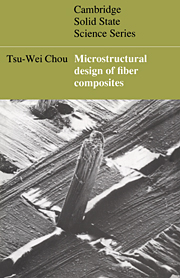Book contents
- Frontmatter
- Contents
- Preface
- 1 Introduction
- 2 Thermoelastic behavior of laminated composites
- 3 Strength of continuous-fiber composites
- 4 Short-fiber composites
- 5 Hybrid composites
- 6 Two-dimensional textile structural composites
- 7 Three-dimensional textile structural composites
- 8 Flexible composites
- 9 Nonlinear elastic finite deformation of flexible composites
- References
- Author index
- Subject index
6 - Two-dimensional textile structural composites
Published online by Cambridge University Press: 10 December 2009
- Frontmatter
- Contents
- Preface
- 1 Introduction
- 2 Thermoelastic behavior of laminated composites
- 3 Strength of continuous-fiber composites
- 4 Short-fiber composites
- 5 Hybrid composites
- 6 Two-dimensional textile structural composites
- 7 Three-dimensional textile structural composites
- 8 Flexible composites
- 9 Nonlinear elastic finite deformation of flexible composites
- References
- Author index
- Subject index
Summary
Introduction
The term ‘textile structural composites’ is used to identify a class of advanced composites utilizing fiber preforms produced by textile forming techniques, for structural applications. The recent interest in textile structural composites stems from the need for improvements in intra- and interlaminar strength and damage tolerance, especially in thick-section composites. Textile composites offer the potential of providing adequate structural integrity as well as shapeability for near-net-shape manufacturing (Chou and Ko 1989).
Textile structural composites provide the unique capability that the microstructure of fiber preforms can be designed to meet the needs of the performance of composite structures. Textile structural composites can be fabricated directly to their final shapes or can be assembled or readily machined to specified contours and dimensions. A total system approach is necessary to optimize the composite performance through the consideration of preform availability, cost, ease of processing, needs for secondary work such as machining, joinability of parts, and the overall performance of the composite structure. Chapters 6 and 7 discuss the fundamental characteristics of two- and three-dimensional textile preforms and the analysis of composite behavior based upon these preforms. The following discussions of yarn assembly, as well as textile preforms and characteristics, are based upon the review of Scardino (1989).
The forming of textile preforms requires knowledge of the structure of yarns and fibers. Yarns are linear assemblages of fibers formed into continuous strands having textile characteristics, i.e. substantial strength and flexibility.
- Type
- Chapter
- Information
- Microstructural Design of Fiber Composites , pp. 285 - 373Publisher: Cambridge University PressPrint publication year: 1992
- 6
- Cited by

